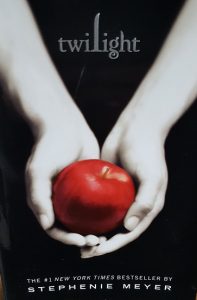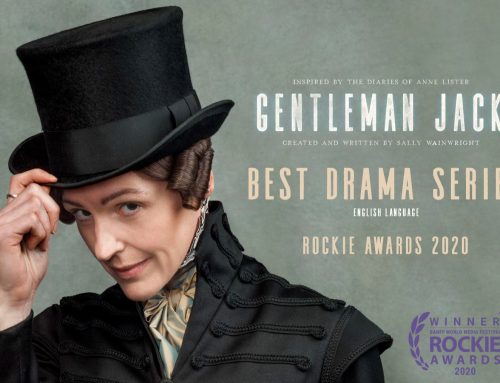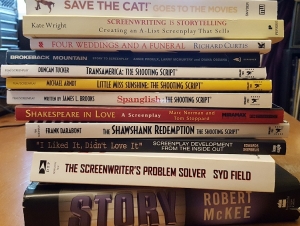by Renée Lukas
 I am not the target audience for the Twilight franchise. A middle-aged lesbian, I’m not on Team Edward or Team Jacob—no wait, Team Edward. But as someone who loves a good story, there’s something pretty great about the Twilight films.
I am not the target audience for the Twilight franchise. A middle-aged lesbian, I’m not on Team Edward or Team Jacob—no wait, Team Edward. But as someone who loves a good story, there’s something pretty great about the Twilight films.
With the release of the newest book, Midnight Sun, there’s been a resurgence of Twilight chatter, and I feel compelled to add to it. First, I’m not talking about the books in this blog, only the films. Second, I could devote an entire blog to the double standard of bashing a successful franchise because of its largely female target audience. (Does anyone analyze all of the ridiculous plot points in Avengers and Transformers films? Hello?) In this blog, however, I’m focusing only on the merits of the Twilight films.
Like it or hate it, the concept of Twilight is a good story. A good story will hold your attention, fascinate you, stay on your mind long after you’ve seen it, and compel you to watch it again. I have proof that Twilight checks these boxes, not only for myself.
Not long ago, my teenage son, who likes to gripe whenever the films come on TV, lingered in the doorway, acting like he was leaving, and watched all the way to the end of Eclipse with me. Why? I’m guessing because he wanted to see how the fight with the “newborns” turned out.
My mother, who is in her seventies, watched all five films in one day and into the night long after my dad went to bed. She told me she couldn’t go to sleep until she saw what happened next.
This is what a good story does. It draws you into another world that you want to stay in for a while. I felt the same way watching Harry Potter films, Avatar, some of the Star Wars films, and shows like Breaking Bad, Orange is the New Black and many others.
The Power is in the Premise
As a writer, your goal should be to write something with a concept as strong as Twilight. I don’t mean you should mimic something about vampires—I’m talking about a premise that immediately reveals what the conflict is going to be.
A sample logline for Twilight might be: A teenage girl falls in love with a vampire.
Sounds very simple, but is instantly wrought with conflict. You already know that this relationship is going to be tricky because she’s human, vampires tend to kill humans, other people in this girl’s life may not be so happy about this, etc., etc. There are so many possibilities already there to explore!
Conflict is Key
Since conflict propels a story forward, Twilight is filled with it. Talk about a forbidden romance! As a lesbian author, I love the forbidden. Give me some good angst any day. A mortal with a vampire? Absolutely. A relationship doomed to fail? Yes please!
(Warning: Spoilers Ahead)
So let’s look at some of the major conflicts in Twilight. You have forbidden love, vampires living among humans, Edward’s internal conflict about not wanting to be a monster, and Bella wanting to be a part of a forbidden world.
A Theme That Inspires You
The best films not only entertain, but they also inspire with a theme, or message, that moves you. For those who complain that it’s just a franchise about a girl choosing between two guys—one who’s always shirtless, etc., I would invite them to watch Eclipse, particularly the very end. Bella’s monologue here is key—where she explains to Edward that it was never a choice between him and Jacob, but a choice between who she should be and who she is. Maybe in some way, I can relate to this theme, because the world pulls at you to be who everyone thinks you are, and you may discover that person isn’t really you, whether you’re gay, trans, or anything that makes you feel different and/or isolated.
So you see, anyone can relate to that theme. When my mom was in grade school, she was never one of those kids who could color inside the lines or do what the teacher wanted. She marched to her own drum and saw no problem with that. As a result, she got in a lot of trouble. Naturally, I knew that there was something in the Twilight universe that she’d love—also, she’s a big fan of horror and supernatural movies. Of course, it was a perfect fit.
Dynamic Scene Structure
What holds someone’s attention when they walk into a room and a Twilight film is on? Dynamic scenes. Here are just a few examples of dynamic scenes that keep you on edge:
At the end of New Moon, the Volturi decide that Bella knows too much and will therefore have to be killed. The scene is the ultimate roller coaster ride, with Bella willing to sacrifice herself for Edward, then he comes within inches of his life (Edward is frequently about to get his head yanked off in these films, and it’s Bella who saves him at the last minute), an up-and-down series of moments where you know she can’t die (it’s only the second film!) but you don’t know how she’ll make it out of this situation.
In Breaking Dawn Part I, we believe Bella is going to die because we think she’s giving birth to something akin to the alien that popped out of a character’s chest in the movie, Alien. We don’t know if she’ll survive. It looks like she’s not long for this world—or even the immortal one. Carlisle’s grave warning that he can’t see the fetus or stop it is chilling. It’s another edge-of-your-seat moment.
The end of Breaking Dawn Part 2 has been widely criticized, but I thought it worked perfectly. First of all, audiences expected a visual, action-packed climax between the Cullens and the Volturi. To have both sides talk it over and decide on peace would have been way more disappointing. Some people feel cheated by the fact that it was “the fight scene that never was,” much like the “oh, it was all a dream” device. However, using Alice’s ability to see the future, and knowing that the future she sees can change depending on a person’s choices, it made perfect sense for her character to be the one that provides this big moment. Remember, callbacks to things we know from earlier in the story make future situations plausible. I thought it was pretty clever, after I’d finished screaming at the TV because I thought Carlisle had died.
The Basics of Screenplay Structure
The very first Twilight is an excellent learning tool for studying structure. As a screenwriter, I always used to struggle with structure. When I studied the first Twilight, I began to see it, like a kaleidoscope coming into focus. The three acts are more clearly defined in this film than many others, so it’s a good one to study. Each act leads into the next with the drama and suspense necessary to keep someone who’s hanging in the doorway watching until the end. Try keeping that in mind when you’re writing your own script. Imagine a restless, easily bored, teenager, hanging in the doorway. Of course, not all stories are meant to keep teens interested, nor should they. But if you feel your script starting to get sluggish, think of what would wake YOU up if you were watching your own movie. Major kudos to Melissa Rosenberg, screenwriter of the Twilight films, for screenplays that get to the emotional heart of each film, while keeping us on edge.
A Feminist Who Likes Twilight?
As a film theory major in college, I completely understand the arguments about the messages sent by certain films. Edward is a controlling boyfriend, and every controlling thing he does is under the guise of “protecting her.” But no, that’s not good. If I’d had my way, I’d have rewritten parts where he disables her truck so she can’t see Jacob. After all, you want to root for this couple, not hate Edward.
I have two responses to the feminist argument against Twilight:
1) I’d argue that there are many other potentially despicable messages and images that girls are inundated with that deserve closer examination. How about the onslaught of gratuitous female nudity in films and streaming shows? It’s often one-sided. I had to laugh at all the snickering and squirming over Jake’s shirtlessness, even when Edward says, “Doesn’t that guy own a shirt?” It seems to make men pretty uncomfortable when the amount of skin shown is theirs. What’s that saying? Turnabout is fair play?
2) I tend to view Twilight more as a fantasy, because vampires and werewolves don’t really exist. Despite some of Edward’s cringeworthy moves, Bella in the films, thanks to Kristen Stewart, is a strong character who evolves from a stuttering, clumsy girl to one who finds her ultimate power through immortality—to me, a very feminist message. It’s like an insecure girl feeling empowered by a new career, a calling, something that gives her confidence. As mentioned earlier, her character arc from who the world says she should be to owning who she really is—this, to me, is another feminist message.
Should Midnight Sun Be a Movie?
I can’t answer this, as I haven’t yet read Midnight Sun. Seeing the story from Edward’s perspective doesn’t seem as interesting as other perspectives I would have loved to see explored more. For instance, the Cullens are full of dramatic story potential. I’d love to see them in the 1940s or earlier, traveling to Forks, Carlisle’s story of becoming a vampire and how that conflicted with his desire to help people as a doctor, the love stories of the Cullen clan—it seems there’s so much great material there. After all, characters that have been around for centuries would, and should, have a lot of experiences and gained wisdom that the rest of us will never know. That in itself makes a great story.
I wrote this post because there’s so much Twilight bashing, and when all is said and done, there’s a reason why the movies are so popular. There’s an enduring story there with universal feelings and fears. That’s something all of us writers should aspire to.
Renée Lukas is the author of four novels: The Comfortable Shoe Diaries, Hurricane Days, Southern Girl and In Her Eyes (Bella Books). She’s also a screenwriter, an Academy Nicholl Quarterfinalist and a reader for BlueCat Screenwriting Competition.



